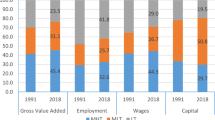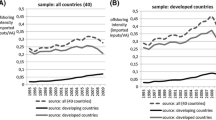Abstract
This paper examines the joint impact of international trade and technological change on UK wages across different skill groups. International trade is measured as changes in product prices and technological change as total factor productivity (TFP) growth. We take account of a multi-sector and multi-factor of production economy and use mandated wage methodology in order to create an well-balanced approach in terms of theoretical and empirical cohesion. We use data from the EU KLEMS database and analyse the impact of both product price changes and TFP changes of 11 UK manufacturing sectors on factor rewards of high-, medium- and low-skilled workers. Results show that real wages of skill groups are significantly driven by the sector bias of price change and TFP growth of several sectors of production. Furthermore, we estimate the share of the three different skill groups on added value for each year from 1970 to 2005. The shares indicate structural change in the UK economy. Results show a structural change owing to decreasing shares of low-skilled workers and increasing shares of medium-skilled and high-skilled workers over the years.

Similar content being viewed by others
Notes
Further references concerning mandated wage methodology can be found in Slaughter (2000).
The framework considers only the production side of only one single economy. Thus the model does not imply factor price equalisation along Samuelson (1948). The analysis imposes no assumptions on cross-country similarities or on consumption side.
The real wage of high-skilled workers to medium-skilled workers is relatively stable over time which stands in contrast to results based on micro level data.
References
Acemoglu D (2002) Technical change, inequality, and the labor market. J Econ Lit 40(1):7–72
Attanasio O, Pinelopi G, Pavcnik N (2004) Trade reforms and wage inequality in Columbia. J Dev Econ 74(2):331–366
Baldwin RE, Cain GG (2000) Shifts in relative US wages: the role of trade, technology and factor endowments. Rev Econ Stat 82(4):580–595
Baldwin RE, Hilton RS (1984) A technique for indicating comparative costs and predicting changes in trade ratios. Rev Econ Stat 66:105–110
Berman E, Bound J, Machin S (1998) Implications of skill biased technological change: international evidence. Q J Econ 113(4):1245–1279
Berman E, Bound J, Griliches Z (1994) Changes in the demand for skilled labor within US manufacturing: evidence from the annual survey of manufactures. Q J Econ 109(2):367–397
Berndt E, Wood D (1982) The specification and measurement of technical change in US manufacturing. In: Advances in the economics of energy and resources, vol. 4. JAI Press, pp. 199–221
Bhagwati J, Dehejia VH (1994) Freer trade and wages of the unskilled–is marx striking again? In: Bhagwati J, Kosters M (eds) Trade and wages: leveling wages down?, Ch. 2. Washington, AEI, pp. 36–75
Bound J, Johnson G (1992) Changes in the structure of wages in the 1980’s: an evaluation of alternative explanations. Am Econ Rev 82(3):371–392
Cuyvers L, Stojanovska N (2010) The interplay between international trade and technological change and the wage inequality in the OECD countries. In: FIW working paper, No. 43
De Santis RA (2003) Wage inequality in the United Kingdom: trade and/or technology? World Econ 26:893–909
Desjonqueres T, Machin S, van Reenen J (1999) Another nail in the coffin? Or can the trade based explanation of changing skill structures be resurrected? Scand J Econ 101(4):533–554
Dornbush R, Fischer S, Samuelson PA (1980) Heckscher-Ohlin trade theory with a continuum of goods. Q J Econ 95:203–224
Ethier WJ (1984) Higher dimensional issues in trade theory. In: Jones RW, Kenen PB (eds) Handbook of international economics 1. North Holland, Amsterdam, pp 131–184
EU KLEMS Growth and productivity accounts: March 2008 release, groningen growth and Development Centre, http://www.euklems.net
Feenstra RC, Hanson GH (1999) The impact of outsourcing and high-technology capital on wages: estimates for the United States, 1979–1990. Q J Econ 114(3):907–940
Feenstra RC, Hanson GH (1997) Productivity measurement and the impact of trade and technology on wages: estimates for the US, 1972–1990. NBER working papers, No. 6052, National Bureau of Economic Research
Findlay R, Grubert H (1959) Factor intensities, technological progress and the terms of trade. Oxf Econ Pap 11:111–121
Gosling A, Machin S, Meghir C (2000) The changing distribution of male wages in the UK. Rev Econ Stud 67(4):635–686
Grainger H, Crowther M (2007) Trade union membership 2006. Department of Trade and Industry
Greenaway D, Reed G, Winchester N (2002) Trade and rising wage inequality in the UK: results from a CGE analysis. In: GEP working paper, no. 02/29
Griliches Z (1969) Capital-skill complementarity. Rev Econ Stat 5:465–468
Haskel J, Slaughter MJ (2002) Does the sector bias of skill-biased technical change explain changing skill premia? Eur EconRev 46:1757–1783
Haskel J, Slaughter MJ (2001) Trade, technology and UK wage inequality. Econ J 111:163–187
Johnson G, Stafford F (1993) International competition and real wages. Am Econ Rev 83(2):127–131
Jones RW et al (1971) A three-factor model in theory, trade and history. In: Bhagwati J (ed) Trade, balance of payments and growth: papers in international economics in honour of Charles P. Kindleberger. Amsterdam, North Holland
Jones RW, Scheinkman JA (1977) The relevance of the two-sector production model in trade theory. J Polit Econ 85:909–935
Karoly L, Burtless G (1995) Demographic change, rising earnings inequality, and the distribution of well-being, 1959–1989. Demography 32:379–405
Katz L, Murphy K (1992) Changes in relative wages 1963–1987: supply and demand factors. Q J Econ 107(1):35–78
Lawrence R (1996) Single world, divided nations? International trade and OECD labor markets. The Brookings Institution, Washington
Lawrence R, Slaughter MJ, Hall RE, Davis SJ, Topel RH (1993) International trade and American wages in the 1980s: giant sucking sound or small hiccup? Brookings Pap Econ Act Microecon 1993(2):161–226
Leamer E (1997) In search of Stolper-Samulson effects on U.S. wages. In: Susan Collins (eds.) Imports, Exports and the American Worker, Brookings, pp. 141–214
Levinsohn J (1999) Employment responses to international liberalization in Chile. J Int Econ 47(2):321–344
Machin S, van Reenen J (1998) Technology and changes in skill structure: evidence from seven OECD countries. Q J Econ, MIT Press 113(4):1215–1244
Mayer W (1974) Short and long run equilibria for a small open economy. J Polit Econ 82:955–967
Michaelsen MM (2011) The hidden increase in wage inequality: skill-biased and ability-biased technological change. Ruhr economic papers, no. 0262
Morrison Paul C (1999) Cost structure and the measurement of economic performance: productivity, utilization, cost economics, and related performance indicators. Kluwer Academic Publishers
Murphy K, Welch F (1991) The role of international trade in wage differentials. In: Kosters (ed) Workers and their wages: changing patterns in the US. Washington, AEI, pp. 39–69
Mussa M (1974) Tariffs and the distribution of income: the importance of factor specificity, substitutability and intensity in the short and the long run. J Polit Econ 82:1191–1203
Neary P (1978) Short-run capital specificity and the pure theory of international trade. Econ J 88:488–510
Nelson RR, Phelps ES (1966) Investment in humans, technological diffusion, and economic growth. Am Econ Rev 56:69–75
Neven D, Wyplosz C (1996) Relative prices, trade and restructuring in European industry. CEP discussion paper, no. 1451
Sachs J, Shatz H (1998) International trade and wage inequality in the US: some new results. In: Collins (ed) Imports, exports and the American worker, Ch. 5. Brookings Institution Press, Washington, pp 215–254
Sachs J, Shatz H (1994) Trade and jobs in US manufacturing. Brookings Pap Econ Act 1:1–69
Samuelson P (1948) International trade and the equalisation of factor prices. Econ J 58:163–184
Savin NE, White KJ (1977) The durbin-watson test for serial correlation with extreme sample sizes or many regressors. Econometrica 45:1989–1996
Schmitt J (1996) The changing structure of male earnings in Britain, 1974-88. In: Freeman Richard B, KatzLawrence F (eds) Differences and changes in wage structures. University of Chicago Press and NBER, Chicago, pp 177–204
Slaughter M (2000) What are the results of product price studies and what can we learn from their differences? In: Feenstra RC (ed) The impact of international trade on wages. University of Chicago Press/NBER, Chicago, pp 129–165
Stolper W, Samuelson P (1941) Protection and real wages. Rev Econ Stud 9:58–73
Taylor K, Driffield N (2005) Wage inequality and the role of multinationals: evidence from UK panel data. Labour Econ 12(2):223–249
Author information
Authors and Affiliations
Corresponding author
Electronic supplementary material
Below is the link to the electronic supplementary material.
Appendix
Appendix
1.1 Cost functions of a two sector and two factor economy
Based on Eq. (5) the factor price ratio of sector 1 reveals as
and based on Eq. (6) the factor price ratio of sector 2 reveals as
Hence, factor intensity of sector 1 is given by
and of sector 2 by
Reinserting factor intensity (35) into (5) yields
Hence, by rearranging, the cost function of sector 1 reveals as
Reinserting factor intensity (36) into (6) yields
Hence, by rearranging, the cost function of sector 2 reveals as
1.2 Determination of factor prices of a two sector and two factor economy
The equation system (8) reveals in matrix notation as
Solving by Cramer’s Rule yields
whereby determinants are given by
with adjoints \(\Upphi_{11}=\alpha_{22}, \Upphi_{21}=-\alpha_{12},\Upphi_{12}=-\alpha_{21}\) and \(\Upphi_{22}=\alpha_{11}.\) Hence, the factor price of the economy reveals for factor 1 as
and for factor 2 as
1.3 Cost functions of a M sector and N factor economy
Based on Eq. (15) the factor price ratios reveal as
Thus, factor intensities are given by
Reinserting the factor intensities (48) into Eq. (15) yields
With \(\Uppi \alpha_{ik}^{\alpha_{ij}}=\alpha_{ik}^{\Upsigma\alpha_{ij}}=\alpha_{ik}\) and \(\Uppi w_{k}^{\alpha i_{j}}=w_{k}^{\Upsigma \alpha_{ij}}=w_{k}\) the cost functions reveal as
1.4 Determination of factor prices of a M sector and N factor economy
With \(\ln w_{j}=\nu_{j}\) and \(\ln \overline{p_{j}}=\eta _{j}\) the system (17) in matrix notation reveals as
\(\underline{\Upphi}\) is the matrix with α − components, ν j the unknowns and η j the right hand side. The matrix \(\underline{\Upphi}\) is nonsingular. Solving (51) by Cramer’s Rule yields
Using \(\underline{\Upphi}\) and substituting the ith-column by the right hand side of (51), denoting the result \(\underline{\Upphi_{i}}\), it follows for case i = 1
Expansion of the first column yields
Hence, the general solution of the equation system (17) reveals as
Rearranging (55) and denoting \(\overline{p_{i}}=A_{i}p_{i}\prod\nolimits_{k=1}^{n}\alpha_{ik}^{\alpha _{ik}},\Upphi=\det (\underline{\Upphi}), \beta_{ij}=\Upphi_{ij}/\Upphi,\alpha_{j}=\prod\nolimits_{i=1}^{n}(\prod\nolimits_{k=1}^{n}\alpha_{ik}^{\alpha_{ik}})^{\Upphi_{ij}}\) and \(\gamma_{j}=\frac{1}{\Upphi}\ln\alpha_{j}\) the factor prices of the economy reveal as
Rights and permissions
About this article
Cite this article
Engelmann, S. International trade, technological change and wage inequality in the UK economy. Empirica 41, 223–246 (2014). https://doi.org/10.1007/s10663-013-9209-z
Published:
Issue Date:
DOI: https://doi.org/10.1007/s10663-013-9209-z




